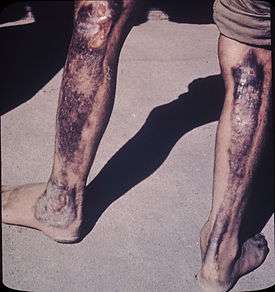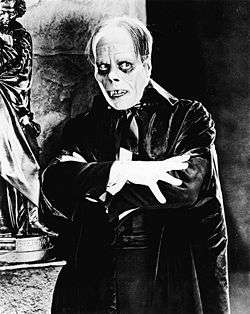Disfigurement

Disfigurement is the state of having one's appearance deeply and persistently harmed medically, such as from a disease, birth defect, or wound. General societal attitudes towards disfigurement have varied greatly across cultures and over time, with cultures possessing strong social stigma against it often causing psychological distress to disfigured individuals. Alternatively, many societies have regarded some forms of disfigurement in a medical, scientific context where someone having ill will against the disfigured is viewed as anathema. In various religious and spiritual contexts, disfigurement has been variously described as being as a punishment from the divine for sin (such as Yahweh's defacement of Cain for Abel's murder in Judaism), as being (such as Paul of the New Testament's arguments about Christ's sufferings) caused by supernatural forces of hate and evil against the good and just, which will be later atoned for, or as being without explanation per se with people just having to endure.
The topic has been frequently commented on and referred to in a great many forms of fictional media as well. Villainous examples include the iconic fiend The Joker from various DC Comics and the mysterious figure with a "red right hand" from the song of the same name by band Nick Cave and the Bad Seeds. Heroic examples include Daredevil, a crime-fighter who was rendered blind (from Marvel Comics), and the compassionate character Edward Scissorhands from the film of the same name.
Overview
Disfigurement, whether caused by a benign or malignant condition, often leads to severe psychosocial problems such as negative body image; depression; difficulties in one's social, sexual, and professional lives; prejudice; and intolerance. This is partly due to how the individual copes with looking 'visibly different', though the extent of the disfigurement rarely correlates with the degree of distress the sufferer feels. An additional factor which affects sufferers of a disfigurement is the reaction they get from other people. Studies have shown that the general population respond to people with a disfigurement with less trust, less respect and often try to avoid making contact or having to look at the disfigurement. Disfigurements affecting visible areas such as the face, arms and hands are thought to present greater difficulty for sufferers to cope with than do other disfigurements.
Deliberate mutilation resulting in physical disfigurement has also been practiced by many cultures throughout human history for religious or judicial purposes. During the Byzantine Empire, the emperor was considered God's viceregent on Earth, and as such the physical wholeness of his person was an essential complement to the perfection of Heaven. For this reason, many deposed emperors were blinded, had their noses cut off, or their tongue split by their successors, as these permanent disfigurements disqualified them from ever reclaiming the throne.
A case of voluntary disfigurement is that of St. Æbbe the Younger and the nuns of Coldingham Monastery in Scotland. When the monastery was attacked by Vikings and they feared being raped, she and the nuns cut off their own noses and upper lips. In revenge, the Vikings burned down the building with the nuns inside. This is said to be the origin of the phrase "cutting off the nose to spite the face".
Causes

Conditions that can cause disfigurement include:
Plastic surgery or reconstructive surgery is available in many cases to disfigured people. Some health insurance companies and government health care systems cover plastic surgery for these problems when they do not generally cover plastic surgery for what is labeled as "cosmetic purposes".
The term "disfigurement" is sometimes used pejoratively to describe the results of intentional body modification. Scarification and other forms of such modification will sometimes be referred to as such by neutral parties or by advocates of the processes as well. Many types of body modification are subject to strong social debate as such.
Disfigurement in fiction

- In most every adaptation (literary, stage, film, or otherwise) of The Phantom of the Opera, the title character (known as "Erik" or "The Phantom") wears either a full or half-face mask to conceal a disfigurement. Some adaptations infer that his disfigurement was present from birth, such as in the Andrew Lloyd Webber musical, whereas others infer or show it to be the result of a horrible accident such as burning from fire or chemicals. The Phantom's disfigured face is usually described as having caused him anguish and despair, thus influencing him to adopt the enigmatic "phantom" persona.[1]
- The DC Comics character the Joker, often a foe of Batman, possesses a clown-like grin and a grotesque combination of bleached skin, red lips, and green hair that are typically described or inferred to be the result of injuries and disfigurement in most media. A common origin of his skin and hair colors revolve around chemical burns as the result of the Joker character either falling into, jumping into, or being thrown into a vat of noxious chemicals. In Tim Burton's 1989 film adaptation of Batman, the Joker character, in this version a criminal originally known as "Jack Napier", receives his distinct "grin" as the result of a botched plastic surgery that he received after a ricocheted bullet that Napier intended to harm Batman badly injured the Joker's face. In most media, the Joker's mania and insanity begin as a result of him seeing his own disfigurement, the 1989 film being an example.[2][3][4][5]
- Several enemies of fictional British secret agent James Bond have been known for their distinctive facial features. An example is the North Korean criminal and terrorist Zao from the film Die Another Day. Played by Rick Yune, the terrorist has partly translucent skin with thick veins shown on his face as well as numerous diamonds embedded into his skin.[6]
- The Punisher, an antihero appearing in various Marvel Comics related works, has confronted several enemies known for their drastic facial disfigurement. A prominent example is Jigsaw, a sadist and psychopath with an incredible stamina while having no superhuman powers that has a deeply mutilated face somewhat akin to a jigsaw puzzle. Perhaps the Punisher's most iconic nemesis, he was played in 2008's Punisher: War Zone by Dominic West.[7]
- Nick Cave and the Bad Seeds' popular alternative rock song "Red Right Hand", first released in 1994's Let Love In, describes a nightmarish figure with a blood-red, disfigured hand (as referred to in the title.[8]
See also
- AboutFace – Canadian charitable organization
- Changing Faces (charity) – British charitable organization
- Dermatology
- Face transplant – experimental treatment for severe facial disfigurement
References
| Look up disfigurement in Wiktionary, the free dictionary. |
External links
- Changing Faces - a British organization for people with facial disfigurements
- Project Harar - a British organization helping children with facial disfigurements in Africa
- Let's Face It - an American organization for people with facial disfigurements
- Unique Face - a Japanese organization for people with facial disfigurements
- Centre for Appearance Research - Psychological and psychosocial research at the University of the West of England, Bristol, UK
- Derriford Appearance Scale - a standardised psychological measure of distress and dysfunction in relation to disfigurement and visible difference